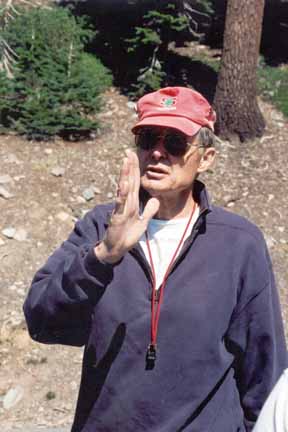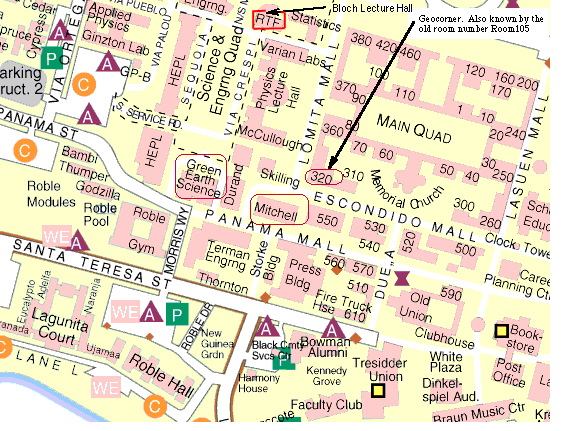see map
Anyone wishing to attend the lecture only is welcome at no cost.
This will be the 339th meeting since 1954.
Abstract
The geology, structure, mineralogy, and geochemistry of the Barcroft granodioritic pluton and adjacent bedrock units have been investigated in order to understand better the mineral parageneses and tectonic evolution of the region. A new, colored geologic map of an area of about 180 sq km has been completed on a topographic base at a scale of 1:24,000. Along the California-Nevada state line, the NNW-trending White-Inyo Range defines the western limit of the Basin and Range province. In the central White Mountains, the Middle Jurassic Barcroft pluton occupies a northeast-trending, steeply southeast-dipping suture-the Barcroft structural break-that cuts across the mountain belt at ~90°. This high-angle reverse fault downdropped pre-existing, recrystallized superjacent mid-Mesozoic, mildly alkaline, bimodal White Mountain Peak metavolcanic rocks and associated volcanogenic metasedimentary units on the north against an uppermost Proterozoic-lowermost Paleozoic stratified quartzite and carbonate metasedimentary platform succession on the south. Eastward, the 163 ± 2 Ma Barcroft pluton is faulted against the ~175 Ma Cottonwood Quartz Monzonite, and both are intruded by the 100-83.6 Ma McAfee Creek Granite; westward, the Barcroft pluton is overlain by Quaternary talus and alluvial deposits in Chalfant Valley. Subparallel SE and NW borders of the pluton display the intrusive nature of its emplacement: although locally faulted, unambiguous igneous contacts are evident along these margins. In addition, finer grained, ferromagnesian Barcroft granodiorite and metadiorite lenses occur as early-stage dikes and sills in the adjacent wall rocks along both intrusive contacts. The pluton contains scattered, incompletely digested metaquartzite inclusions along the southern border, and metavolcanic + volcaniclastic metasedimentary blocks within and toward its northern and northeastern margins, thus it must have invaded the Barcroft structural break at least partly molten. Except along the southern margin, the Barcroft pluton is not strongly flow banded.Three different intrusive igneous units are represented in the study area: (1) Middle Jurassic, I-type, metaluminous plutonic rocks of the Barcroft comagmatic suite-mineralogically and chemically intergradational, chiefly mafic granodiorite, gabbro/diorite, metadiorite, and rare alaskite-aplite; (2) Late Cretaceous, apparently S-type, faintly peraluminous granitic plutons sensu stricto of the McAfee Creek suite-differing among themselves only in grain size; and (3), Tertiary, unmetamorphosed, fine-grained diabase dikes. Members of the Barcroft granodioritic pluton are K-poor, exhibit a broad range of mineralogic compositions, and appear to represent the products of fractional crystallization. The younger, K-rich granite sensu stricto suite is quite homogeneous, as is the yet younger, more mafic diabasic dike series.
These three contrasting intrusive igneous series + adjacent superjacent units on the north and south testify to the inferred plate-tectonic history of the region: (a) evolution of a long-lived passive margin from latest Proterozoic through early Mesozoic time (interrupted by contractional events of the Antler and Sonoma orogenies); (b) mid-Mesozoic subduction, partial fusion of the downgoing lithospheric slab and/or the overlying mantle wedge, and ascent of voluminous, relatively refractory magma attending Andean-style volcanic-plutonic arc production; (c) Late Cretaceous crustal thickening, heating, and partial melting of recycled, deeply buried, fusible sialic materials; and (d), Tertiary Basin and Range asthenospheric upwelling, lithospheric transtension, and the tapping of minor amounts of upper mantle interstitial melts. Tilting and strike-slip faulting accompanied Plio-Pleistocene uplift and glaciation of the White Mountain block. Continuing elevation of the Sierra Nevada and White-Inyo ranges may reflect enlargement of the subcrustal high-temperature realm (shallowing of the lithosphere-asthenosphere boundary), resulting from westward encroachment of North American lithosphere over the East Pacific Rise heat source. The region constitutes a typical example of the Phanerozoic evolution of the Californian continental margin. At least, I think so!
About the Speaker
Growing up in St. Paul, Minnesota, Ernst attended public schools there, then Carleton College (B. A. in Geology, 1953), University of Minnesota (M. Sc. In Geology, 1955) and The Johns Hopkins University (Ph. D in Geochemistry in 1959). After NSF and Geophysical Laboratory pre- and post-doctoral fellowships, in 1960, Ernst joined the faculty of the University of California, Los Angeles, was professor of Geology and Geophysics, chairman of the Department of Geology, 1970-1974, chairman of the Department of Earth and Space Sciences, 1978-1982, and, 1987-1989, UCLA director of the Institute of Geophysics and Planetary Physics. On September 1, 1989 he moved to Stanford University for a five-year term as dean of the School of Earth Sciences. Since 1999, he has held the Benjamin M. Page Chair, School of Earth Sciences, Stanford University,Ernst was chairman of the Board on Earth Sciences of the National Research Council (1984-87), served on the NRC Board on Earth Sciences and Resources (1988-1993), and is a trustee of the Carnegie Institution of Washington, D.C. (1990-present). Member, National Academy of Sciences (chairman, section of Geology, 1979-82; secretary, Class I, Physical Sciences, 1997-2000, chair, 2000-present), American Philosophical Society. Fellow: American Academy of Arts and Sciences; American Geophysical Union; American Association for the Advancement of Science (chair section on geology and geography, 2001), Geological Society of America (president, 1985-86); Mineralogical Society of America (president, 1980-81). Author of six books and research memoirs, editor of 14 other research volumes, and author of more than 180 scientific papers (and numerous abstracts, book reviews, etc.) dealing with: (1) the physical chemistry of rocks and minerals; (2) the Phanerozoic interactions of lithospheric plates and mobile mountain belts, especially in central Asia, the Circumpacific and the western Alps; (3) early Precambrian petrotectonic evolution; (4) ultrahigh-pressure subduction-zone metamorphism and tectonics; and (5) Earth System science/remote sensing.
Fulbright Research Scholar, University of Tokyo, 1963; Crosby Visiting Professor, M. I. T., 1968; MSA Award recipient, 1969; NSF Senior Postdoctoral Fellow and Adjunct Professor, University of Basel, 1970-71; Guggenheim Memorial Fellow and Visiting Extraordentlich Professor, Swiss Federal Institute, Zürich, 1975-76; William Evans Visiting Professor, Otago University, Dunedin, New Zealand, 1982-83, Visiting Professor, Universitade Federale de Pernambuco, Recife, Brazil, 1988; Japan Society for the Promotion of Science Fellow, and Visiting Professor, Kyoto University, 1995. He received the Geological Society of Japan Medal for 1998.

Gary Ernst demo-ing acreation (photo by Mary Jane Coombs)
Reservations: The preferred way to make reservations is simply to email Janice Sellers at janice@seismosoc.org by Friday, October 12, tell her you will attend, commit to pay, and bring your payment to the meeting. Janice always emails a confirmation; if you don't get one, assume email crashed yet again and email her a second time. A check made to"PGS"is preferred, payable at the meeting.
If you want to pay in advance:
Stanford faculty and students: Please make dinner reservations by Friday, October 12. Contact Dr. Juhn Liou via his mailbox (and leave check), Geological and Environmental Sciences Office, Geocorner - Bldg. 320 (Rm. 118). Make checks out to"PGS."
All others, including faculty and students from other Bay Area universities and colleges and USGS: Please make dinner reservations by Friday, October 12. Contact Janice Sellers, at Seismological Society of America, 201 Plaza Professional Building, El Cerrito, CA 94530, phone (510) 559-1780. Send check made out to"PGS"to Janice.
Dinner is $26.00. Includes wine (5:30 to 6:15 PM.), dinner (6:15-7:30 PM.), tax, and tip. Note: PGS does not make revenue on this price.

